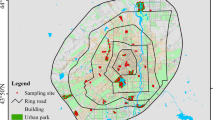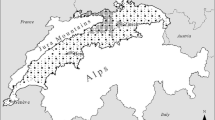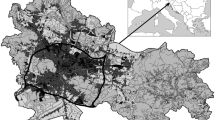Abstract
Urban heat islands (UHIs) represent a serious problem for urban biodiversity and landscapes. The impact of UHIs on Japanese gardens are of particular concern because these gardens use moss as a ground cover, and moss can be strongly affected by UHIs due to their sensitivity to drought stress. We studied 17 historical gardens in Kyoto, Japan, and propose an effective management strategy for moss gardens that takes into account the influence of UHIs on these gardens. The study sites included gardens covered by large patches of hygrophilous moss, gardens covered by mosses including small patches of hygrophilous moss, gardens covered by relatively drought-resistant moss, and gardens with small patches of mosses. We measured temperature and relative humidity within the gardens and determined the surrounding land-use types. A comparison of microclimates showed significant differences among garden types. Hygrophilous gardens had the lowest temperature and highest relative humidity, whereas gardens with small patches of moss had the highest temperature and lowest relative humidity. Using structural equation models, we determined that urbanization within 1000 m from the gardens increased temperature and decreased relative humidity, strongly affecting the type of garden. These effects could be attributed to the sensitivity of mosses to changes in microclimate caused by UHIs. Taken together, the results indicate that urban planning—e.g., increasing green space—within 1000 m of moss gardens can maintain those gardens by mitigating the influence of UHIs.





Similar content being viewed by others
References
Alberti M, Marzluff J (2004) Ecological resilience in urban ecosystems: linking urban patterns to human and ecological functions. Urban Ecosyst 7:241–265
Ca VT, Asaeda T, Abu EM (1998) Reductions in air conditioning energy caused by a nearby park. Energ Build 29:83–92
Carpenter B, Gelman A, Hoffman MD, Lee D, Goodrich B, Betancourt M, Brubaker M, Guo J, Li P, Riddell A (2017) Stan: a probabilistic programming language. J Stat Softw. https://doi.org/10.18637/jss.v076.i01
Chiesura A (2004) The role of urban parks for the sustainable city. Land Urban Plan 68:129–138
Cregg BM, Dix ME (2001) Tree moisture stress and insect damage in urban areas in relation to heat island effects. J Arboric 27:8–17
Dilks TJK, Proctor MCF (1974) The pattern of recovery of bryophytes after desiccation. J Bryol 8:97–115
Fan S, Li S, Han J, Hao P, Dong L (2018) Assessing the effects of landscape characteristics on the thermal environment of open spaces in residential areas of Beijing, China. Landsc Ecol Eng 14:79–90
Frahm J-P (1987) Which factors control the growth of epiphytic bryophytes in tropical rainforests? Symp Biol Hung 35:639–648
Frahm J-R (1990) Bryophyte phytomass in tropical ecosystems. Bot J Linn Soc 104:23–33
Fujibe F (2009) Detection of urban warming in recent temperature trends in Japan. Int J Climatol 29:1811–1822
Gago EJ, Roldan J, Pacheco-Torres R, Ordonez J (2013) The city and urban heat islands: a review of strategies to mitigate adverse effects. Renew Sust Energ Rev 25:749–758
Gelman A, Rubin D (1992) Inference from iterative simulation using multiple sequences. Stat Sci 7:457–511
Gotsch SG, Davidson K, Murray JG, Duarte VJ, Draguljić D (2017) Vapor pressure deficit predicts epiphyte abundance across an elevational gradient in a tropical montane region. Am J Bot 104:1790–1801
Hasegawa J (2002) Bryophyte flora in Saihoji temple (Koke-dera). In: Kyoto prefecture (ed) The red data book of Kyoto prefecture 2002, vol 2. Landforms, Geology, and Natural Communities, Kyoto Prefecture, Kyoto, pp 292–297 (in Japanese)
Ishii S, Sato N (2012) Secular change of fog frequency in some Japanese cities. J Geogr Soc Hosei Univ 44:15–30 (in Japanese)
Japan Meteorological Agency (2014) Monitoring reports on heat islands. http://www.data.jma.go.jp/cpdinfo/himr/2014/himr2014.pdf. Accessed 11 January 2018 (in Japanese)
Japan Meteorological Agency (2017) Past meteorological data. http://www.jma.go.jp/jma/menu/menureport.html. Accessed 11 January 2018 (in Japanese)
Jauregui E (1990) Influence of a large urban park on temperature and convective precipitation in a tropical city. Energ Build 15–16:457–463
Knapp S, Kühn I, Wittig R, Ozinga WA, Poschlod P, Klotz S (2008) Urbanization causes shifts in species’ trait state frequencies. Preslia 80:375–388
Kowarik I (2011) Novel urban ecosystems, biodiversity and conservation. Environ Pollut 159:1974–1983
Kyoto City (2017) Total survey on tourism in Kyoto. http://www.city.kyoto.lg.jp/sankan/cmsfiles/contents/0000222/222031/28chousa.pdf. Accessed 11 January 2018 (in Japanese)
Lee SH, Lee KS, Jin WC, Song HK (2009) Effect of an urban park on air temperature differences in a central business district area. Landsc Ecol Eng 5:183–191
Liu W, You H, Dou J (2009) Urban–rural humidity and temperature differences in the Beijing area. Theor Appl Climatol 96:201–207
Madlener R, Sunak Y (2011) Impacts of urbanization on urban structures and energy demand: what can we learn for urban energy planning and urbanization management? Sustain Cities Soc 1:45–53
Ministry of the Environment (2017) Vegetation map (a scale of 1 to 25000). http://gis.biodic.go.jp/webgis/sc-025.html?kind=vg67. Accessed 11 January 2018 (in Japanese).
Molla M (2015) The value of urban green infrastructure and its environmental response in urban ecosystem: a literature review. Int J Env Sci 4:89–101
Nazim A, Ahmad S (2013) A comparison between ordinary least square (OLS) and structural equation modeling (SEM) methods in estimating the influential factors of 8th grades student’s mathematics achievement in Malaysia. Int J Sci Eng Res 4:717–722
Oishi Y (2009) A survey method for evaluating drought-sensitive bryophytes in fragmented forests: a bryophyte life-form based approach. Biol Conserv 142:2854–2861
Oishi Y (2012) Influence of urban green spaces on the conservation of bryophyte diversity: the special role of Japanese gardens. Land Urban Plan 106:6–11
Oishi Y (2015a) Kokezanmai. Iwanamishoten, Tokyo (in Japanese)
Oishi Y (2015b) Changes in epiphyte diversity in declining forests: implications for conservation and restoration. Landsc Ecol Eng 11:283–291
Oishi Y, Hiura T (2017) Bryophytes as bioindicators of atmospheric environment in urban-forest landscapes. Land Urban Plan 167:348–355
Oishi Y, Morimoto Y (2016) Identifying indicator species for bryophyte conservation in fragmented forests. Landsc Ecol Eng 12:107–114
Penny MG, Bayfield NG (1982) Photosynthesis in desiccated shoots of Polytrichum. New Phytol 91:637–645
Peterson G, Allen C, Holling C (1998) Ecological Resilience, Biodiversity, and Scale. Ecosystems 1:6–18
R Core Team (2017) R: A language and environment for statistical computing. R foundation for statistical computing, Vienna, Austria. http://www.R-project.org/
Ryu YH, Baik JJ (2011) Quantitative analysis of factors contributing to heat island intensity. J Appl Meteorol Climatol 51:842–854
Stan Development Team (2017) RStan: The R interface to Stan. R package version 2.16.2. Retrieved from http://mc-stan.org
Tilman D, Wedin D, Knops J (1996) Productivity and sustainability influenced by biodiversity in grasslands ecosystems. Nature 379:718–720
Acknowledgments
We are grateful to all the people in temples and shrines and the NHK Broadcasting Corporation who cooperated in this study. This study was funded by the CFAAS Research Project Budget from Fukui Prefectural University.
Author information
Authors and Affiliations
Corresponding author
Electronic supplementary material
Below is the link to the electronic supplementary material.
Rights and permissions
About this article
Cite this article
Oishi, Y. Urban heat island effects on moss gardens in Kyoto, Japan. Landscape Ecol Eng 15, 177–184 (2019). https://doi.org/10.1007/s11355-018-0356-z
Received:
Revised:
Accepted:
Published:
Issue Date:
DOI: https://doi.org/10.1007/s11355-018-0356-z




